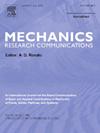Influence of photothermal and photoacoustic waves of thermally shocked microtemperature semiconductor materials
IF 2.3
4区 工程技术
Q3 MECHANICS
引用次数: 0
Abstract
Photothermal (PT) and photoacoustic (PA) processes are two closely related phenomena that occur in semiconductor materials that are exposed to light energy or optical beam absorption and surface recombination in and on the sample. These phenomena have been studied in semiconductor materials because they have important applications in various sectors, including renewable energy and sensing. The elastic and thermal problem in one dimension is solved by adding photothermal excitation and photoacoustic waves on the free surface of a semi-infinite semiconducting medium. The governing equations of the problem under the influence of a microtemperature field are solved using the integral transform technique. The inverse Laplace method is used to solve the mathematical problem. Temperature, acoustic pressure, elastic and mechanical distributions, microtemperature and heat flux distributions, and carrier density diffusion are all physical parameters that can be determined from the mathematical model's numerical solutions. The numerical results obtained from several comparisons are discussed and illustrated graphically. The most significant result indicates that microtemperature effects and photogenerated carrier lifetimes greatly influence semiconductor media's thermal and elastic wave behavior, which is crucial for microstructure-based photothermal design.
热冲击微温度半导体材料的光热波和光声波影响
光热(PT)和光声(PA)过程是两种密切相关的现象,发生在半导体材料暴露于光能或光束吸收和样品表面复合的过程中。这些现象在半导体材料中得到了研究,因为它们在包括可再生能源和传感在内的各个领域都有重要的应用。通过在半无限半导体介质的自由表面上加入光热激励和光声波来解决一维的弹性和热问题。利用积分变换技术求解了微温度场影响下的控制方程。用拉普拉斯逆变换法求解数学问题。温度、声压、弹性和力学分布、微温度和热流分布以及载流子密度扩散都是可以从数学模型的数值解中确定的物理参数。讨论了几次比较得到的数值结果,并用图形说明了结果。最重要的结果表明,微温度效应和光生载流子寿命极大地影响半导体介质的热波和弹性波行为,这对于基于微结构的光热设计至关重要。
本文章由计算机程序翻译,如有差异,请以英文原文为准。
求助全文
约1分钟内获得全文
求助全文
来源期刊
CiteScore
4.10
自引率
4.20%
发文量
114
审稿时长
9 months
期刊介绍:
Mechanics Research Communications publishes, as rapidly as possible, peer-reviewed manuscripts of high standards but restricted length. It aims to provide:
• a fast means of communication
• an exchange of ideas among workers in mechanics
• an effective method of bringing new results quickly to the public
• an informal vehicle for the discussion
• of ideas that may still be in the formative stages
The field of Mechanics will be understood to encompass the behavior of continua, fluids, solids, particles and their mixtures. Submissions must contain a strong, novel contribution to the field of mechanics, and ideally should be focused on current issues in the field involving theoretical, experimental and/or applied research, preferably within the broad expertise encompassed by the Board of Associate Editors. Deviations from these areas should be discussed in advance with the Editor-in-Chief.

 求助内容:
求助内容: 应助结果提醒方式:
应助结果提醒方式:


